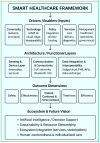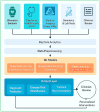Machine Learning-Powered Smart Healthcare Systems in the Era of Big Data: Applications, Diagnostic Insights, Challenges, and Ethical Implications
- PMID: 40804880
- PMCID: PMC12346079
- DOI: 10.3390/diagnostics15151914
Machine Learning-Powered Smart Healthcare Systems in the Era of Big Data: Applications, Diagnostic Insights, Challenges, and Ethical Implications
Abstract
Healthcare data rapidly increases, and patients seek customized, effective healthcare services. Big data and machine learning (ML) enabled smart healthcare systems hold revolutionary potential. Unlike previous reviews that separately address AI or big data, this work synthesizes their convergence through real-world case studies, cross-domain ML applications, and a critical discussion on ethical integration in smart diagnostics. The review focuses on the role of big data analysis and ML towards better diagnosis, improved efficiency of operations, and individualized care for patients. It explores the principal challenges of data heterogeneity, privacy, computational complexity, and advanced methods such as federated learning (FL) and edge computing. Applications in real-world settings, such as disease prediction, medical imaging, drug discovery, and remote monitoring, illustrate how ML methods, such as deep learning (DL) and natural language processing (NLP), enhance clinical decision-making. A comparison of ML models highlights their value in dealing with large and heterogeneous healthcare datasets. In addition, the use of nascent technologies such as wearables and Internet of Medical Things (IoMT) is examined for their role in supporting real-time data-driven delivery of healthcare. The paper emphasizes the pragmatic application of intelligent systems by highlighting case studies that reflect up to 95% diagnostic accuracy and cost savings. The review ends with future directions that seek to develop scalable, ethical, and interpretable AI-powered healthcare systems. It bridges the gap between ML algorithms and smart diagnostics, offering critical perspectives for clinicians, data scientists, and policymakers.
Keywords: artificial intelligence; big data; electronic health records (EHRs); machine learning; smart diagnostics; smart healthcare systems.
Conflict of interest statement
The authors declare no conflicts of interest.
Figures










Similar articles
-
Prescription of Controlled Substances: Benefits and Risks.2025 Jul 6. In: StatPearls [Internet]. Treasure Island (FL): StatPearls Publishing; 2025 Jan–. 2025 Jul 6. In: StatPearls [Internet]. Treasure Island (FL): StatPearls Publishing; 2025 Jan–. PMID: 30726003 Free Books & Documents.
-
AML diagnostics in the 21st century: Use of AI.Semin Hematol. 2025 Jun 16:S0037-1963(25)00027-7. doi: 10.1053/j.seminhematol.2025.06.002. Online ahead of print. Semin Hematol. 2025. PMID: 40617702
-
The Use of Machine Learning for Analyzing Real-World Data in Disease Prediction and Management: Systematic Review.JMIR Med Inform. 2025 Jun 19;13:e68898. doi: 10.2196/68898. JMIR Med Inform. 2025. PMID: 40537090 Free PMC article.
-
Advances in artificial intelligence for diabetes prediction: insights from a systematic literature review.Artif Intell Med. 2025 Jun;164:103132. doi: 10.1016/j.artmed.2025.103132. Epub 2025 Apr 15. Artif Intell Med. 2025. PMID: 40258308
-
Intelligent wearable-assisted digital healthcare industry 5.0.Artif Intell Med. 2024 Nov;157:103000. doi: 10.1016/j.artmed.2024.103000. Epub 2024 Oct 22. Artif Intell Med. 2024. PMID: 39481247 Review.
References
-
- Xu G., Fan X., Xu S., Cao Y., Chen X., Shang T., Yu S. Anonymity-Enhanced Sequential Multi-Signer Ring Signature for Secure Medical Data Sharing in IoMT. IEEE Trans. Inf. Forensics Secur. 2025;20:5647–5662. doi: 10.1109/TIFS.2025.3574959. - DOI
-
- Kandeel M. Revolutionizing Healthcare: Harnessing the Power of Artificial Intelligence for Enhanced Diagnostics, Treatment and Drug Discovery. Int. J. Pharmacol. 2024;20:1–10. doi: 10.3923/ijp.2024.1.10. - DOI
-
- Xiao X., Li Y., Wu Q., Liu X., Cao X., Li M., Dai X. Development and validation of a novel predictive model for dementia risk in middle-aged and elderly depression individuals: A large and longitudinal machine learning cohort study. Alzheimer’s Res. Ther. 2025;17:103. doi: 10.1186/s13195-025-01750-6. - DOI - PMC - PubMed
-
- Research and Markets . Global Big Data in Healthcare Market Trends and Forecasts Report 2024: A $540 Billion Industry by 2035, from $67 Billion in 2023. GlobeNewswire; El Segundo, CA, USA: 2024.
-
- Greene L. How Healthcare Data Technology is Leveraged by Leaders. Arcadia Solutions. Sep 6, 2023. [(accessed on 10 May 2025)]. Available online: https://arcadia.io/resources/healthcare-data-technology.
Publication types
LinkOut - more resources
Full Text Sources
Miscellaneous

